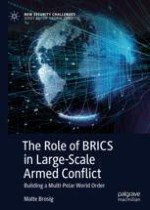2019 | OriginalPaper | Chapter
2. Theoretical Framework: Modeling BRICS Response to Armed Conflict
Author : Malte Brosig
Published in: The Role of BRICS in Large-Scale Armed Conflict
Publisher: Springer International Publishing
Activate our intelligent search to find suitable subject content or patents.
Select sections of text to find matching patents with Artificial Intelligence. powered by
Select sections of text to find additional relevant content using AI-assisted search. powered by
